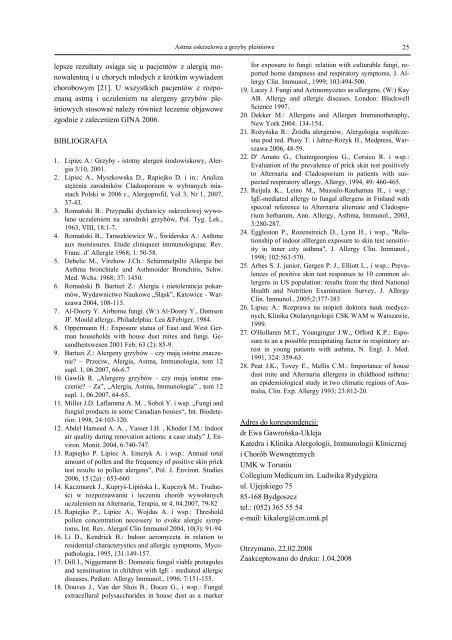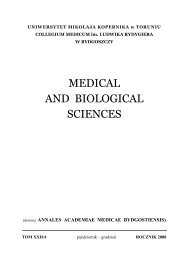24Ewa Gawrońska-Ukleja i in.nym przeciwko grzybom pleśniowym było IgE swoistedla Alternaria species (ok. 7% chorych) [10].W Polsce Lipiec przebadała 814 pacjentów z alergicznymnieżytem nosa i stwierdziła dodatnie testyskórne na grzyby pleśniowe u 11% badanych chorych,z czego w 84% przypadków wynik dodatni dotyczyłalergenów Alternaria [26].ATMA OSKRZELOWA A UCZULENIENA GRZYBY PLEŚNIOWEW wielu pracach obserwuje się obecnie związekmiędzy nasileniem objawów astmy a stężeniem zarodnikówgrzybów pleśniowych w atmosferze. Stwierdzono,że gdy poziom zarodników pleśni w powietrzuatmosferycznym był szczególnie wysoki, rosła liczbazgonów z powodu stanu astmatycznego. Co ciekawe,podobnej zależności nie wykazano w przypadku pyłkówdrzew, traw i ambrozji. W badaniu O'Hollareni wsp. u 99 astmatyków dodatni odczyn w teście skórnymz Alternaria alternata stwierdzono u 31% badanych,natomiast u pacjentów z epizodem nagłego zatrzymaniaoddechu odsetek ten wyniósł aż 91% [27].Ciekawą analizę zgonów z powodu astmy przeprowadziłTargoński i wsp. Ustalili oni że liczba zgonówbyła 2-3 krotnie wyższa w tych dniach, w którychliczba zarodników grzybów w atmosferze wynosiła do1000/ m 3 [6]. Peat i wsp. badał ciężkość astmy zależnieod takich czynników jak płeć, wiek, miejsce zamieszkania,oraz częstość dodatnich testów skórnych naalergeny wziewne. Okazało się że z podanych wyżejwykładników jedynie uczulenie na Alternaria alternatabyło niezależnym czynnikiem ryzyka ciężkiej astmy.Zauważono także, iż chorzy z astmą ciężką podająw wywiadzie częściej występowanie astmy u matki niżu ojca [28].Nuekrich i wsp. stwierdzili że uczulenie na Alternariaalternata jest czynnikiem ciężkiego przebieguastmy. Również Black w 2000 r. obserwował stanyasmatyczne zagrażające życiu u chorych uczulonychna ten alergen. Także Denning i wsp. w 2006 r. potwierdzili,że ciężka astma kojarzy się z uczuleniem naalergeny pleśni [14].Analogiczną zależność obserwuje się u dzieci.W USA ustalono korelacje dodatnich odczynów skórnychna Alternaria u 6-letnich dzieci z uporczywyminapadami astmy, a także z jej wystąpieniem po razpierwszy. W San Diego w Kalifornii przeprowadzonobadania wśród dzieci w wieku 9-18 lat i stwierdzono,że ciężkość objawów astmy kojarzyła się z ekspozycjąna grzyby [9].W Australii zaś Peat i wsp. w badaniach przeprowadzonychu dzieci w regionach bardziej suchychzaobserwowali wyraźną korelacje między występowaniemastmy a ekspozycją na zarodniki Alternarii, zaśw strefach wilgotnych analogiczną relację stwierdzonopomiędzy występowaniem astmy i ekspozycją na roztocza[28].Zjawisko to może być spowodowane nie tylkouczuleniem na alergeny grzybów pleśniowych, aletakże tym, że pleśnie nasilają odpowiedź organizmu nainne alergeny [10].LECZENIEDużą rolę w leczeniu odgrywa zmniejszenie ekspozycjina alergen. Można to osiągnąć, polecając chorymunikanie prac związanych z glebą, głównie grabieniaopadłych liści, grzybobrania, koszenia trawy, a takżeunikania miejsc, gdzie grzyby pleśniowe znajdujądogodne warunki do rozwoju, takich jak sutereny,piwnice, drewniane altanki, domki letniskowe, pomieszczeniagospodarskie na wsi, kryte baseny czysauny. Należy również uważać, aby w pomieszczeniach,gdzie śpią chorzy, nie było wykładzin, tapet, aniroślin doniczkowych. W kuchniach i jadalniach należybezwzględnie wystrzegać się zepsutych jarzyn i owoców.Chory uczulony na grzyby pleśniowe nie możejeść serów pleśniowych, drożdży piekarskich. Objawymoże też powodować wypicie wina, piwa i szampana.Filtry w klimatyzatorach uczulonych pacjentów winnybyć regularnie wymieniane [2, 21].Do leczenia przyczynowego zaliczana jest równieżimmunoterapia swoista. Europejska Akademia Alergologiii Immunologii Klinicznej w 1993 r. zaleciła stosowanieimmunoterapii z alergenami pleśni jedyniew kontrolowanych próbach klinicznych. Natomiast cisami eksperci w roku 2006 rekomendują odczulanieswoiste drogą iniekcji podskórnych, nie zalecają natomiastimmunoterapii podjęzykowej, chociaż w badaniuprzeprowadzonym w Hiszpanii przez Molinę wykazanoskuteczność i bezpieczeństwo immunoterapii podjęzykowejwyciągiem alergenów Alternarii. Tylko jednobadanie porównawcze metody podjęzykowej i podskórnejopublikowano w roku 1996. Potwierdziło onoskuteczność obu metod, natomiast terapia podjęzykowawykazywała mniej efektów ubocznych. Podobniejak w przypadkach immunoterapii swoistej z wyciągamiinnych alergenów powietrznopochodnych, naj-
Astma oskrzelowa a grzyby pleśniowe 25lepsze rezultaty osiąga się u pacjentów z alergią monowalentnąi u chorych młodych z krótkim wywiademchorobowym [21]. U wszystkich pacjentów z rozpoznanąastmą i uczuleniem na alergeny grzybów pleśniowychstosować należy również leczenie objawowezgodnie z zaleceniem GINA 2006.BIBLIOGRAFIA1. Lipiec A.: Grzyby - istotny alergen środowiskowy, Alergia3/10, 2001.2. Lipiec A., Myszkowska D., Rapiejko D. i in.: Analizastężenia zarodników Cladosporium w wybranych miastachPolski w 2006 r., Alergoprofil, Vol 3, Nr 1, 2007,37-43.3. Romański B.: Przypadki dychawicy oskrzelowej wywołaneuczuleniem na zarodniki grzybów, Pol. Tyg. Lek.,1963, VIII, 18:1-7.4. Romański B., Taraszkiewicz W., Świderska A.: Asthmeaux moisissures. Etude cliniqueet immunologique. Rev.Franc. d’ Allergie 1968; 1: 50-58.5. Debelic M., Virchow J.Ch.: Schimmelpiltz Allergie beiAsthma bronchiale und Asthmoider Bronchitis, Schw.Med. Wchs. 1968; 37: 1450.6. Romański B. Bartuzi Z.: Alergia i nietolerancja pokarmów,Wydawnictwo Naukowe „Śląsk”, Katowice - Warszawa2004, 108-115.7. Al-Doory Y. Airborne fungi. (W:) Al-Doory Y., DomsonJF. Mould allergy. Philadelphia: Lea &Febiger, 1984.8. Oppermann H.: Exposure status of East <strong>and</strong> West Germanhouseholds with house dust mites <strong>and</strong> fungi. Gesundheitswesen2001 Feb; 63 (2): 85-9.9. Bartuzi Z.: Alergeny grzybów – czy mają istotne znaczenie?– Przeciw, Alergia, Astma, Immunologia, tom 12supl. 1, 06.2007, 66-6.710. Gawlik R. „Alergeny grzybów – czy mają istotne znaczenie?– Za”, „Alergia, Astma, Immunologia” , tom 12supl. 1, 06.2007, 64-65.11. Miller J.D. Laflamma A. M. , Sobol Y. i wsp. „Fungi <strong>and</strong>fungial products in some Canadian houses“, Int. Biodeterior.1998, 24:103-120.12. Abdel Hameed A. A. , Yasser I.H. , Khoder I.M.: Indoorair quality during renovation actions: a case study” J. Environ.Monit. 2004, 6:740-747.13. Rapiejko P. Lipiec A. Emeryk A. i wsp.: Annual totalamount of pollen <strong>and</strong> the frequency of positive skin pricktest results to pollen alergens”, Pol. J. Environ. Studies2006, 15 (2a) : 653-66014. Kaczmarek J., Kupryś-Lipińska I., Kupczyk M.: Trudnościw rozpoznawaniu i leczeniu chorób wywołanychuczuleniem na Alternaria, Terapia, nr 4, 04.2007, 79-8215. Rapiejko P., Lipiec A., Wojdas A. i wsp.: Thresholdpollen concentration necessery to evoke alergic symptoms,Int. Rev. Alergol Clin Immunol 2004, 10(3): 91-9416. Li D., Kendrick B.: Indoor aeromyceta in relation toresidential characterystics <strong>and</strong> allergic symptoms, Mycopathologia,1995, 131:149-157.17. Dill I., Niggemann B.: Domestic fungal viable protagules<strong>and</strong> sensitisation in children with IgE - mediated allergicdiseases, Pediatr. Allergy Immunol., 1996; 7:151-155.18. Douves J., Van der Sluis B., Doces G., i wsp.: Fungalextracellural polysaccharides in house dust as a markerfor exposure to fungi: relation with culturable fungi, reportedhome dampness <strong>and</strong> respiratory symptoms, J. AllergyClin. Immunol., 1999; 103:494-500.19. Lacey J. Fungi <strong>and</strong> Actinomycetes as allergens. (W:) KayAB. Allergy <strong>and</strong> allergic diseases. London: BlackwellScience 1997.20. Dekker M.: Allergens <strong>and</strong> Allergen Immunotheraphy,New York 2004: 134-154.21. Rożyńska R.: Źródła alergenów, Alergologia współczesnapod red. Płusy T. i Jahnz-Rożyk H., Medpress, Warszawa2006, 48-59.22. D' Amato G., Chatzrgeorgiou G., Corsico R. i wsp.:Evaluation of the prevalence of prick skin test positivelyto Alternaria <strong>and</strong> Cladosporium in patients with suspectedrespiratory allergy, Allergy, 1994, 49: 460-465.23. Reijula K., Leino M., Mussalo-Rauhamaa H., i wsp.:IgE-mediated allergy to fungal allergens in Finl<strong>and</strong> withspecoal reference to Alternaria alternate <strong>and</strong> Cladosporiumherbarum, Ann. Allergy, Asthma, Immunol., 2003,3:280-287.24. Eggleston P., Rozenstreich D., Lynn H., i wsp., "Relationshipof indoor alllergen exposure to skin test sensitivityin inner city asthma", J. Allergy Clin. Immunol.,1998; 102:563-570.25. Arbes S. J. junior, Gergen P. J., Elliott L., i wsp.: Prevalencesof positive skin test responses to 10 common allergensin US population: results from the third NationalHealth <strong>and</strong> Nutrition Examination Survey, J. AllergyClin. Immunol., 2005;2:377-38326. Lipiec A.: Rozprawa na stopień doktora nauk medycznych,Klinika Otolaryngologii CSK WAM w Warszawie,1999.27. O'Hollaren M.T., Younginger J.W., Offord K.P.: Esposureto an a possible precipitating factor in respiratory arrestin young patients with asthma, N. Engl. J. Med.1991, 324: 359-63.28. Peat J.K., Tovey E., Mellis C.M.: Importance of housedust mite <strong>and</strong> Alternaria allergens in childhood asthma:an epidemiological study in two climatic regions of Australia,Clin. Exp. Allergy 1993; 23:812-20.Adres do korespondencji:dr Ewa Gawrońska-UklejaKatedra i Klinika Alergologii, Immunologii Kliniczneji Chorób WewnętrznychUMK w Toruniu<strong>Collegium</strong> <strong>Medicum</strong> im. Ludwika Rydygieraul. Ujejskiego 7585-168 Bydgoszcztel.: (052) 365 55 54e-mail: kikalerg@cm.umk.plOtrzymano. 22.02.2008Zaakceptowano do druku: 1.04.2008
- Page 1 and 2: UNIWERSYTET MIKOŁAJA KOPERNIKA w T
- Page 4 and 5: Medical and Biological Sciences, 20
- Page 6: 6Małgorzata Dowgwiłłowicz-Nowick
- Page 9 and 10: Centralny bezdech senny u chorych z
- Page 11 and 12: Centralny bezdech senny u chorych z
- Page 13: Centralny bezdech senny u chorych z
- Page 16 and 17: 16Grażyna Dymek i in.Zasadniczą c
- Page 18 and 19: 18Grażyna Dymek i in.ny, lamininy
- Page 20 and 21: 20Grażyna Dymek i in.10. Ayad M.S.
- Page 22 and 23: 22Ewa Gawrońska-Ukleja i in.RYS HI
- Page 27 and 28: Medical and Biological Sciences, 20
- Page 29 and 30: Ocena zależności pomiędzy białk
- Page 31 and 32: Ocena zależności pomiędzy białk
- Page 33: Ocena zależności pomiędzy białk
- Page 36 and 37: 36Paulina Dobrowolna, Wojciech Hagn
- Page 39 and 40: Medical and Biological Sciences, 20
- Page 41: Biomechaniczna analiza pozycji sprz
- Page 44 and 45: 44Agnieszka Łukomska i in.WSTĘPGr
- Page 46 and 47: 46Agnieszka Łukomska i in.bezpiecz
- Page 49 and 50: Medical and Biological Sciences, 20
- Page 51 and 52: Repektowanie prawa pacjenta do info
- Page 53: Repektowanie prawa pacjenta do info
- Page 56 and 57: 56Małgorzata Łukowicz i in.Materi
- Page 58 and 59: 58Małgorzata Łukowicz i in.cząt,
- Page 60 and 61: 60Małgorzata Łukowicz i in.badani
- Page 62 and 63: 62Magdalena Mackiewicz-Milewska i i
- Page 64 and 65: 64Magdalena Mackiewicz-Milewska i i
- Page 66 and 67: 66Marta Pokrywczyńska i in.WSTĘPP
- Page 68 and 69: 68Marta Pokrywczyńska i in.Fot. 1.
- Page 71 and 72: Medical and Biological Sciences, 20
- Page 73 and 74: Nadopiekuńczość i zaniedbanie -
- Page 75:
Nadopiekuńczość i zaniedbanie -
- Page 78 and 79:
78Andrzej Zieliński i in.łoocze,
- Page 80 and 81:
80Andrzej Zieliński i in.bocznie u
- Page 83 and 84:
Medical and Biological Sciences, 20
- Page 85 and 86:
Zaostrzenie astmy oskrzelowej u 4-l
- Page 87:
Zaostrzenie astmy oskrzelowej u 4-l
- Page 90:
Medical and Biological Sciences, 20
















